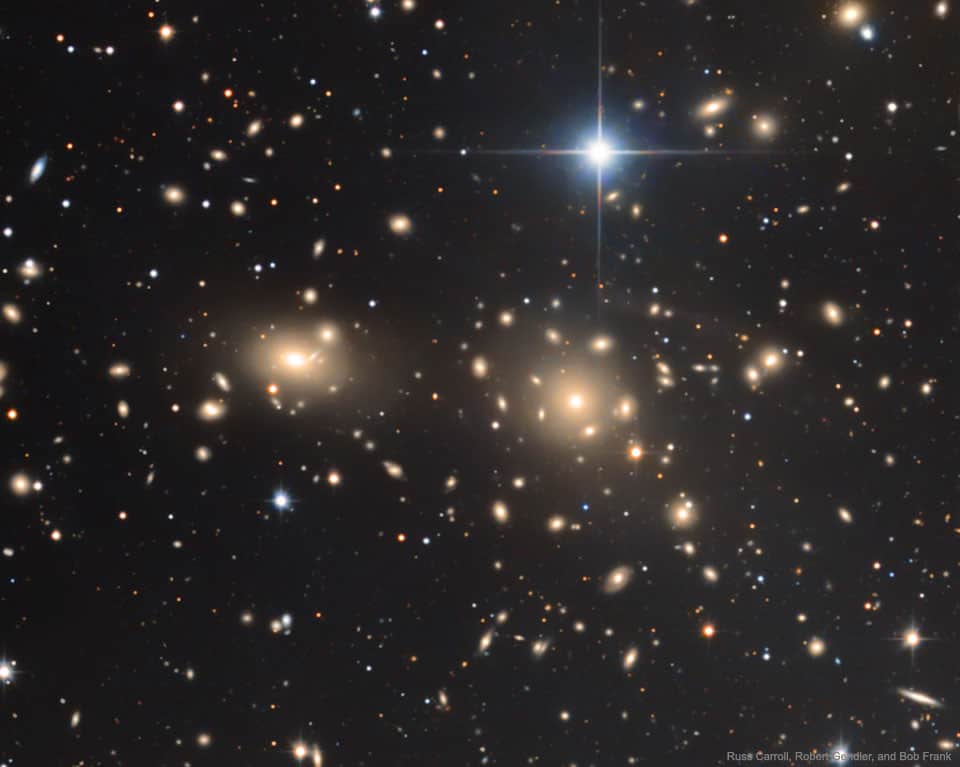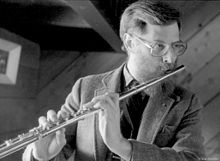Blog
NGC 7252 is a peculiar galaxy resulting from an interaction between two galaxies that started a billion years ago. It is located 220 million light years away in the constellation Aquarius. It is also called Atoms for Peace galaxy, a nickname which comes from its loop-like structure, made of stars, that resembles a diagram of an electron orbiting an atomic nucleus.
NGC 7252 is located in the southern part of Aquarius. With an apparent magnitude of 12.7, it is bright enough to be seen by amateur astronomers as a faint small fuzzy blob. Large loops of gas and stars around it makes the galaxy quite peculiar. Thus, it is also Arp 226 (the 226th entry in Arp’s list of peculiar galaxies).
In December 1953, U.S. President Dwight D. Eisenhower gave the “Atoms for Peace” speech. The speech was concerned about promoting nuclear power for peaceful purposes instead of nuclear weapons. Significant to the scientific community, the name of the speech was given to this peculiar galaxy. The two galaxies merging also resembles nuclear fusion and the galaxies giant loops resemble a diagram of electrons orbiting the nucleus of an atom.
The galaxy is the result of a collision of two galaxies. This collision is an opportunity for astronomers to study such mergers and to predict the future of our Milky Way after its expected collision with the Andromeda galaxy.
X-ray emissions were observed in NGC 7252. This suggests the existence of nuclear activity or an intermediate-mass black hole in the galaxy.
more...Orrin Evans (born 28 March 1975) is an American jazz pianist. Evans was born in Trenton, New Jersey and raised in Philadelphia. He attended Rutgers University, and then studied with Kenny Barron. He worked as a sideman for Bobby Watson, Ralph Peterson, Duane Eubanks, and Lenora Zenzalai-Helm, and released his debut as a leader in 1994. He signed with Criss Cross Jazz in 1997, recording prolifically with the label. He was awarded a 2010 Pew Fellowships in the Arts.
more...Tete Montoliu (28 March 1933 – 24 August 1997) was a jazz pianist from Catalonia, Spain. Born blind, he learnt music in Braille at age seven. His real name was Vicenç Montoliu i Massana. His styles varied from hard bop, through afro-cuban, world fusion, to post bop. He recorded with Lionel Hampton in 1956 and played with the touring Roland Kirk in 1963. He also worked with Kenny Dorham, Dexter Gordon, Ben Webster, Lucky Thompson, and Anthony Braxton. Tete Montoliu’s recorded two albums in the US, and recorded for Enja and Soul Note.
Montoliu was born blind, in the Eixample district of Barcelona, and died in the same city. He was the only son of Vicenç Montoliu (a professional musician) and Àngela Massana, a jazz enthusiast, who encouraged her son to study piano. Montoliu’s first experimenting with the piano took place under the tuition of Enric Mas at the private school for blind children that he attended from 1939 to 1944. In 1944, Montoliu’s mother arranged for Petri Palou to provide him with formal piano lessons.
more...Thaddeus Joseph Jones (March 28, 1923 – August 20, 1986) was an American jazz trumpeter, composer, and bandleader who has been called “one of the all-time greatest jazz trumpet soloists.”
Thad Jones was born in Pontiac, Michigan, on March 28, 1923, to Henry and Olivvia Jones, a musical family of 10 (an older brother was pianist Hank Jones and a younger brother was drummer Elvin Jones). A self-taught musician, Thad began performing professionally at the age of 16. He served in U.S. Army bands during World War II (1943–46).
After his military service, which included an association with the U.S. Military School of Music and working with area bands in Des Moines and Oklahoma City, Jones became a member of the Count Basie Orchestra in May 1954. He was featured as a soloist on such well-known tunes as “April in Paris“, “Shiny Stockings” and “Corner Pocket”. However, his main contribution to Basie’s organization was nearly two dozen arrangements and compositions, which included “The Deacon”, “H.R.H.” (Her Royal Highness — in honor of the band’s command performance in London), “Counter Block”, and lesser known tracks such as “Speaking of Sounds”. His hymn-like ballad “To You” was performed by the Basie band combined with the Duke Ellington Orchestra in their only recording together, and the recording Dance Along With Basie contains nearly an entire album of Jones’ uncredited arrangements of standard tunes.
https://www.youtube.com/watch?v=oKDc__9hTO8
more...Yemaya from Cuba
more...RHYTHM ROOTS WORKSHOP
Tuesday March 27th, 2018 noon-2pm
Partnership Resources Inc St Louis Park
Performance Day at 1pm with SHAKE IT UP percussion team featuring Mike, Angie, Bethany and Deion.
more...Monday, March 26, 2018: A star-forming region in the Milky Way resembles a Van Gogh painting in this stellar view from the European Space Agency’s Herschel space observatory. The image reveals a web of gas filaments, which astronomers believe are responsible for creating new stars. This region is located 7,500 light-years away in the neighborhood of the Carina Nebula.
more...Sarah Lois Vaughan (March 27, 1924 – April 3, 1990) was an American jazz singer. She has been described by music critic Scott Yanow as having “one of the most wondrous voices of the 20th century.”
Nicknamed “Sassy” and “The Divine One“, Vaughan was a four-time Grammy Award winner, including a “Lifetime Achievement Award”. The National Endowment for the Arts bestowed upon her its “highest honor in jazz”, the NEA Jazz Masters Award, in 1989.
Vaughan’s father, Asbury “Jake” Vaughan, was a carpenter by trade and played guitar and piano. Her mother, Ada Vaughan, was a laundress and sang in the church choir. Jake and Ada Vaughan had migrated to Newark, New Jersey from Virginia during the First World War. Sarah was their only biological child, although in the 1960s they adopted Donna, the child of a woman who traveled on the road with Sarah Vaughan.
Biographies of Vaughan frequently state that she was immediately thrust into stardom after a winning amateur night performance at Harlem’s Zeus Theater. In fact, the story seems to be a bit more complex. Vaughan was frequently accompanied by a friend, Doris Robinson, on her trips into New York City. In the fall of 1942, by which time she was 18 years old, Vaughan suggested that Robinson enter the Apollo Theater Amateur Night contest. Vaughan played piano accompaniment for Robinson, who won second prize. Vaughan later decided to go back and compete as a singer herself. She sang “Body and Soul“, and won—although the exact date of this victorious performance is uncertain. The prize, as Vaughan recalled later to Marian McPartland, was $10 and the promise of a week’s engagement at the Apollo. On November 20th, 1942, Vaughan returned to the Apollo to open for Ella Fitzgerald.
more...
Benjamin Francis Webster (March 27, 1909 – September 20, 1973) was an American jazz tenor saxophonist. Born in Kansas City, Missouri, he is considered one of the three most important “swing tenors” along with Coleman Hawkins and Lester Young. Known affectionately as “The Brute” or “Frog”, he had a tough, raspy, and brutal tone on stomps (with growls), yet on ballads he played with warmth and sentiment. He was indebted to alto saxophonist Johnny Hodges, who, he said, taught him to play his instrument.
Webster learned to play piano and violin at an early age before taking up the saxophone, although he did return to the piano from time to time, even recording on the instrument occasionally. Once Budd Johnson showed him some basics on the saxophone, Webster began to play that instrument in the Young Family Band (which at the time included Lester Young). Kansas City at this point was a melting pot from which emerged some of the biggest names in 1930s jazz. Webster joined Bennie Moten‘s band in 1932, a grouping which also included Count Basie, Oran “Hot Lips” Page and Walter Page. This era was recreated in Robert Altman‘s film Kansas City.
Webster spent time with quite a few orchestras in the 1930s, including Andy Kirk, the Fletcher Henderson Orchestra in 1934, then Benny Carter, Willie Bryant, Cab Calloway, and the short-lived Teddy Wilson big band.
more...Leroy Carr (March 27, 1905 – April 29, 1935) was an American blues singer, songwriter and pianist who developed a laid-back, crooning technique and whose popularity and style influenced such artists as Nat King Cole and Ray Charles. He first became famous for “How Long, How Long Blues“, released by Vocalion Records in 1928.
Carr was born in Nashville, Tennessee, and raised in Indianapolis, Indiana. His recording career was cut short by his early death, but he produced a large body of work. Some of his most famous songs include “Blues Before Sunrise” (1932), “Midnight Hour Blues” (1932), and “Hurry Down Sunshine” (1934). He had a longtime partnership with the guitarist Scrapper Blackwell. His light bluesy piano combined with Blackwell’s melodic jazz guitar attracted a sophisticated black audience. Carr’s vocal style moved blues singing toward an urban sophistication, influencing such singers as T-Bone Walker, Charles Brown, Amos Milburn, Jimmy Witherspoon, and Ray Charles, among others.
more...Traditional Kumina drumming in the mountains of Portland Jamaica. Recorded during the January 2011 trip of the Jamaica Field Service Project.
more...Almost every object in the above photograph is a galaxy. The Coma Cluster of Galaxies pictured here is one of the densest clusters known – it contains thousands of galaxies. Each of these galaxies houses billions of stars – just as our own Milky Way Galaxy does. Although nearby when compared to most other clusters, light from the Coma Cluster still takes hundreds of millions of years to reach us. In fact, the Coma Clusteris so big it takes light millions of years just to go from one side to the other. Most galaxies in Coma and other clusters are ellipticals, while most galaxies outside of clusters are spirals. The nature of Coma’s X-ray emissionis still being investigated.
322.9 million light years away.
more...Diana Ernestine Ross (born March 26, 1944 Detroit, MI) is an American singer, songwriter, actress, and record producer. Born and raised in Detroit, Michigan, Ross rose to fame as the lead singer of the vocal group the Supremes, which, during the 1960s, became Motown’s most successful act, and are the best charting girl group in US history, as well as one of the world’s best-selling girl groups of all time. Ross’ success as lead singer of the Supremes helped to make it possible for future African-American R&B and soul acts to find mainstream success.The group released a record-setting twelve number-one hit singles on the US Billboard Hot 100, including “Where Did Our Love Go“, “Baby Love“, “Come See About Me“, “Stop! In the Name of Love“, “You Can’t Hurry Love“, “You Keep Me Hangin’ On“, “Love Child“, and “Someday We’ll Be Together“.
Following her departure from the Supremes in 1970, Ross released her eponymous debut solo album that same year, which contained the Top 20 Pop hit “Reach Out and Touch (Somebody’s Hand)” and the number-one Pop hit “Ain’t No Mountain High Enough“. She later released the album Touch Me in the Morning in 1973; its title track reached number 1, as her second solo #1 hit. That same year, her album Lady Sings the Blues, which was the original soundtrack of her film based on the life of jazz singer Billie Holiday, went to no. 1 on the Billboard 200 Albums Chart, selling more than 300,000 copies within its first 8 days of release. By 1976, the Mahogany soundtrack included her third number-one hit, “Theme from Mahogany (Do You Know Where You’re Going To)“. Her eponymous 1976 album included her fourth number-one hit, “Love Hangover“. In 1979, Ross released the album The Boss. Her 1980 semi-eponymous album diana reached number 2 on the US Billboard albums chart, and spawned the number-one hit “Upside Down“, and the Top 5 international hit “I’m Coming Out“. Ross’ final single with Motown during her initial run with the company achieved her sixth and final US number-one Pop hit, the duet “Endless Love“, composed for the Brooke Shields film of the same name, by and performed with Commodores front man, Lionel Richie. Ross and Richie performed the song on the telecast for the 54th Academy Awards, where the song was nominated in the category of “Best Song”. The success of the single launched Richie’s record-breaking solo career.
more...Lewis Barry Tabackin (born March 26, 1940) is a jazz flutist and tenor saxophonist. He is married to pianist Toshiko Akiyoshi, with whom he has co-led large ensembles since the 1970s.
Critic Scott Yannow describes Tabackin as “one of the few jazz musicians who has been able to develop completely different musical personalities on two instruments”, with his forceful hard bop style on sax contrasting with his delicate flute playing.
Tabackin first took up the flute at the age of 12, followed by the tenor saxophone at age 15. He has citied Al Cohn and Coleman Hawkins as influences on his sax playing, while his flute role models include classical players such as William Kincaid, Julius Baker, and Jean-Pierre Rampal.Tabackin studied flute at the Philadelphia Conservatory of Music and also studied music with composer Vincent Persichetti. In 1962 he graduated from the Conservatory and, after a stint with the U.S. Army, worked with Tal Farlow. He also worked with Chuck Israels in New York City, and a combo that included Elvin Jones, Donald Byrd, and Roland Hanna. Later he would have a chair in The Dick Cavett Show‘s band and The Tonight Show Bandwith Doc Severinsen. Tabackin moved from New York to California when The Tonight Show relocated in 1972. During this time he played with Shelly Manne and Billy Higgins, among others.
more...James Moody (March 26, 1925 – December 9, 2010) was an American jazz saxophone and flute player and very occasional vocalist, playing predominantly in the bebop and hard bop styles.
Moody had an unexpected hit with “Moody’s Mood for Love,” a 1952 song written by Eddie Jefferson that used as its melody an improvised solo that Moody had played on a 1949 recording of “I’m in the Mood for Love.” Moody adopted the song as his own, recording it with Jefferson on his 1956 album Moody’s Mood for Love and performing the song regularly in concert, often singing the vocals himself.
James Moody was born in Savannah, Georgia, and was raised by his (single) mother, Ruby Hann Moody Watters. He had a brother, Louis.Growing up in Newark, New Jersey, he was attracted to the saxophone after hearing George Holmes Tate, Don Byas, and various saxophonists who played with Count Basie, and later also took up the flute.
https://www.youtube.com/watch?v=akVlKVr4cvg
more...Rufus C. Thomas, Jr. (March 26, 1917 – December 15, 2001)[1][2][3] was an American rhythm-and-blues, funk, soul and blues singer, songwriter, dancer, DJ and comic entertainer from Memphis, Tennessee. He recorded for several labels, including Chess Records and Sun Records in the 1950s, before becoming established in the 1960s and 1970s at Stax Records. He is best known for his novelty dance records, including “Walking the Dog” (1963), “Do the Funky Chicken” (1969) and “(Do the) Push and Pull” (1970). According to the Mississippi Blues Commission, “Rufus Thomas embodied the spirit of Memphis music perhaps more than any other artist, and from the early 1940s until his death . . . occupied many important roles in the local scene.
Thomas was born in the rural community of Cayce, Mississippi, the son of a sharecropper. He moved with his family to Memphis, Tennessee, around 1920. His mother was a “church woman”. Thomas made his debut as a performer at the age of six, playing a frog in a school theatrical production. By the age of 10, he was a tap dancer, performing on the streets and in amateur productions at Booker T. Washington High School, in Memphis.From the age of 13, he worked with Nat D. Williams, his high-school history teacher, who was also a pioneer black DJ at radio station WDIA and columnist for black newspapers, as a master of ceremonies at talent shows in the Palace Theater on Beale Street. After graduating from high school, Thomas attended Tennessee A&I University for one semester, but economic constraints led him to leave to pursue a career as a full-time entertainer.
Thomas began performing in traveling tent shows.In 1936 he joined the Rabbit Foot Minstrels, an all-black revue that toured the South, as a tap dancer and comedian, sometimes part of a duo, Rufus and Johnny. He married Cornelia Lorene Wilson in 1940, at a service officiated by the Rev. C. L. Franklin (the father of Aretha Franklin), and the couple settled in Memphis. Thomas worked a day job in the American Finishing Company textile bleaching plant, which he continued to do for over 20 years. He also formed a comedy and dancing duo, Rufus and Bones, with Robert “Bones” Couch, and they took over as MCs at the Palace Theater, often presenting amateur hour shows. One early winner was B.B. King, and others discovered by Thomas later in the 1940s included Bobby Bland and Johnny Ace
more...Kong Nay was born March 15, 1944 in Kampot, Cambodia.
more...More Posts
- Dewey Redman
- Jackie McLean
- World Music with Ehsan Matoori
- Daily Roots with Conscious Youth
- The Cosmos with NGC 602
- Robert Fripp
- Billy Cobham
- Betty Carter
- World Music with Hagar & Lenny Tunes
- Daily Roots with Sista Awa
- The Cosmos with M8
- Brian Eno
- Ellis Larkins
- Edmond Hall
- World Music with Dobet Gnahoré
- Daily Roots with Moon Rocks & Prince Jazzbo
- The Cosmos with M104
- David Byrne
- Jack Bruce
- Zutty Singleton




